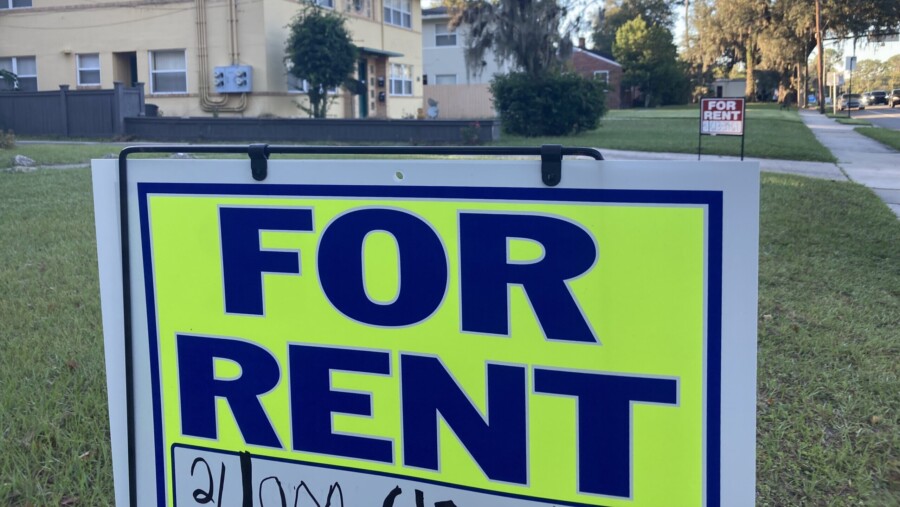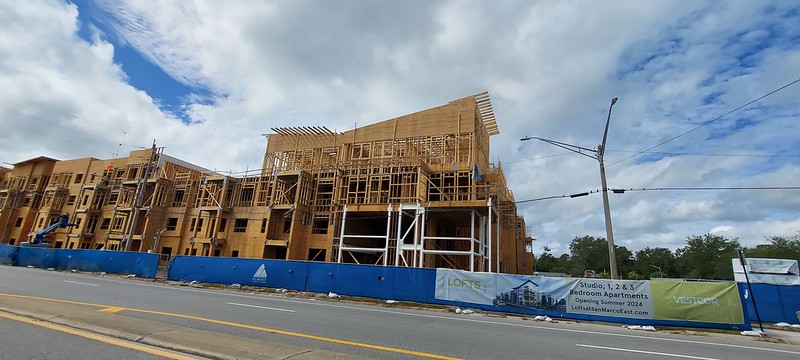
“Just remember this, Mr. Potter, that this rabble you’re talking about, they do most of the working and paying and living and dying in this community. Well, is it too much to have them work and pay and live and die in a couple of decent rooms and a bath?”
-Jimmy Stewart as George Bailey in It’s a Wonderful Life
Parts of Jacksonville already are like Pottersville.
It’s the American dream to own your own home. That dream looks impossible to a growing number of Northeast Florida residents. Large sections of Jacksonville, especially in low-income neighborhoods, are dominated by rentals, often owned by out-of-town investors.
Now the affordable housing crisis is moving to the middle class — people like nurses, teachers, police officers and firefighters — as a supply shortage has allowed rents to rise fast. Incomes have not kept pace, especially in fast-growing areas like Jacksonville.
To illustrate how the housing market has changed, here is a personal story: My wife and I came to Jacksonville in 1973, 50 years ago. We moved into an apartment complex on Parental Home Road. In 1976, my wife realized that we could afford homeownership.
The small house we bought in San Marco — two bedrooms and one bath — had been a rental, so it needed repairs, but we were willing to do that in order to build equity. It was our first step toward starting a family.
Jacksonville’s housing market hadn’t yet become hot. The city had tolls and smelly paper mills and some of the highest electric rates in the country. San Marco had a Pic N’ Save. The nation during the 1970s suffered through two energy crises, recessions and “stagflation” (a recession combined with inflation). In 1981, when we bought our second house in San Marco, the average mortgage rate had surged to 16%.
Still, home prices were reasonable. Jacksonville, without a pro football team, had yet to be discovered. We could afford the mortgage with two entry-level incomes. Nevertheless, we could only get a 25-year mortgage.
We were lucky. Today, we would have a tough time finding a starter home in the Jacksonville area with a double whammy of high mortgage rates and home prices — and, for many, college loans.
Here are a few of the depressing statistics (Don’t be deterred by all of the bad news; I saved some good news for the end of this column):
- In 1958, the year before Barbie was introduced, the median price of a home in the U.S. was $19,214, or $202,850 in today’s dollars. Today’s median home price is double that, $410,000. (Source: AARP Magazine)
- Today, a U.S. buyer with a median income can only afford a house worth half the price of a house in 2020. Why? Interest rates rose from 2.68% to 7.63%. Home prices haven’t dropped much because current homeowners with low mortgage interest rates aren’t moving and home construction hasn’t kept pace with the demand.
- The cost of owning a home vs. renting one is at its most extreme level since 1996. The average new mortgage payment is 52% higher than the average apartment rent, reported CBRE in The Wall Street Journal.
- In August, it took an income of $99,549 to afford the median-priced home in Jacksonville of $365,000, reported Redfin News.
- New starter homes are rarely being built and older homes are being snatched up by investors.
In fact, today some new homes are being built that are intended to be permanent rentals. That is mind-boggling. Something is distressing about an entire ZIP code filled with rental houses.
David Jaffee, a professor of sociology at the University of North Florida, addressed rental affordability in a February report, “Jacksonville’s Affordable Rental Housing Crisis: Description, Diagnosis and Potential Policy Solutions.”
The problem is easily summarized: Rents have surged in recent years while incomes have not kept pace. Therefore, it is “virtually impossible” for workers to find apartments they can afford.
Jaffee in the report distinguishes between a Jacksonville resident who owns a few rental homes — a mom-and-pop landlord — and a corporate landlord who bundles rental property into an investment vehicle for wealthy investors.
In Duval County, the property appraiser estimates that 25% of all single-family homes are owned by investors. Jacksonville — like Atlanta, Charlotte and Las Vegas — has been discovered as an investment opportunity.
From 2015 to 2020, investor acquisitions of housing increased by 96%. Jaffee quoted one investment website: “Jacksonville, Florida is home to a perfect combination of low home prices, high rental rates and high property appreciation — making investing here so appealing.”
Many of the neighborhoods with the greatest increases in rents are the majority-Black ones, which were redlined by government fiat before redlining was banned by the Fair Housing Act of 1968.
According to a 2021 paper from the Federal Reserve Bank Research Division, investor purchases increase home prices, especially in the bottom price tier, where most first-time home buyers find themselves. The researchers concluded: “Overall, our results suggest that investors had a significant role in worsening housing affordability …”
Jaffee notes if housing is treated as just another commodity left to the private sector, it is not producing enough affordable housing.
The government must get involved to increase supply in sectors that the private market is unable or unwilling to meet.
The role of nonprofits
Public-private partnerships can also fill in the gaps, as can Jacksonville’s outstanding nonprofit community, which has been misunderstood. Nonprofits can’t provide total solutions to big problems like affordable housing but they can take risks that government is reluctant to make. Studies and pilot programs conducted by nonprofits can pave the way for big commitments that Jacksonville’s government has been unwilling to make.
If you look at funding locally, there is consistent support for funding public safety and the Jacksonville Jaguars. Other needs typically get funded on a token basis.
So United Way of Northeast Florida needs to be commended for its special committee and its plans to spend $10 million on affordable housing over three main categories: Preservation, infill development and capacity of nonprofit and community development districts.
I am totally confident that United Way will follow through on its plans. I am far less confident that the government will scale up funding to make a meaningful dent in affordable housing.
Tokenism is not a solution.
Housing is not just another commodity, it is a basic human need like food. And the fact that it is a generator of wealth undermines efforts to provide more affordable housing. In fairness, institutional investors aren’t entirely responsible for the affordable housing crisis.
In an email, Jaffee explained that he doesn’t have many good solutions for dealing with this. “No local or state government, as far as I know, has figured out a way to effectively control concentrated ownership,” he wrote.
Jaffee is working to establish a local tenants’ union to confront landlords. A proposal to pass a local tenant bill of rights has been nullified by action of the Florida Legislature.
Jaffee also says that recent scandals involving poor living conditions at corporate-owned apartment complexes are just the “tip of the iceberg.”
As a start, he proposes transparency through a public registry of corporate owners and landlords and national legislative proposals to tax corporate landlords.
In California, certainly not a role model for affordability, a law passed in 2020 reduces the advantage of big corporations to purchase homes in bulk in foreclosure auctions by favoring owner-occupants, tenants, local governments and housing nonprofits.
Another idea comes from Cincinnati, where the Port of the Greater Cincinnati Development Authority spent $14.5 million to outbid institutional investors for 194 homes in a receivership sale. These will be converted from rentals to occupant-owned homes. Cincinnati leveraged public funds with grants and loans. Of course, a similar Jacksonville effort would need revenue to jump at such opportunities.
Locally, Jaffee says there is a need for an agency to coordinate the various programs aimed at providing affordable housing. He mentioned the Housing Leadership Council of Palm Beach County as a role model.
Bottom line: The city’s 50% share of a $2 billion stadium-entertainment district development amounts to $1 billion, or about $86 million per year over 30 years. My suggestion: The city should match its share with an equal amount for resiliency, affordable housing and infrastructure improvements in historically neglected neighborhoods.
Home purchasing advice
During interviews for previous columns on the affordable housing crisis, I asked two experts for their advice for first-time home buyers.
Jaimie Ross, longtime head of the Florida Housing Coalition and an affordable housing expert, said that finding the right location remains the No. 1 goal.
“Find the smallest house in the best neighborhood you can afford,” she said. “Its value will go up disproportionately per square foot.”
Shannon Nazworth, CEO of Ability Housing, recommends that buyers be certain they can afford the house. In today’s market, adjustable-rate loans can provide false hope if the terms are not carefully examined.
“Don’t be house-poor,” Nazworth said. “Know what you can really afford. Don’t presume that things will be better tomorrow with your income. Just because the bank approves you for a loan, don’t presume that’s what you should be going for.”
Consider starting with a townhouse or a condo, which often are less expensive than a single-family home.
Finally, once you find a home to buy, check local flood maps. Is the home in a flood plain or near one? Visit the neighborhood after a heavy rainfall. Even if your home is not in an official flood plain, buy flood insurance. Flooding in this era of climate chaos is setting new records.
More help for home buyers
All is not lost for would-be first-time home buyers in Jacksonville. Two city programs and a redlining settlement give some buyers, limited by income or neighborhood, aid for downpayment and closing costs, as well as counseling.
These items, though welcome, don’t come close to resolving the historic racial injustices and the current housing affordability crisis.
A redlining settlement between the U.S. Justice Department and Ameris Bank of Atlanta seeks to address the lack of lending taking place in majority Black and Hispanic neighborhoods in Jacksonville. Though Ameris denied the allegations, the bank agreed to provide a variety of programs such as training for staff, advertising, community partnerships and financial programs for residents. A total of $7.5 million will be allocated to subsidies in areas affected by modern redlining — areas that even today are well-known majority African American neighborhoods. However, each applicant may receive up to $20,000, an amount that may not be enough for many potential homeowners.
And while the recent action from the U.S. Justice Department on redlining in Jacksonville was welcome, why wasn’t the city of Jacksonville taking similar action long ago?
How much money will it take to rectify decades of the housing injustices suffered by Jacksonville’s African American residents? Mayor Donna Deegan told a town hall meeting on resiliency organized by Jacksonville Today that the city can afford to fund resiliency programs to combat rising water levels and a new football stadium and entertainment district. So what is the funding target? And can the city also afford to fund a new jail, infrastructure improvements in redlined neighborhoods and subsidies for affordable housing?
The city of Jacksonville does have a program called Head Start to Home Ownership, operated by the Housing and Community Development Division. Travis Jeffrey, the division chief, has a 25-year history in that department.
In a phone interview, Jeffrey noted that the program offers aid for down payments, closing costs and interest rate reductions. They are offering up to a $50,000 down payment aid for people at 80% of the Area Median Income and below. That income limit translates to about $49,600 for a single person or $70,800 for a family of four.
At one point, the city was awarding $15,000 to $20,000 amounts but, with housing prices surging, it was determined that $50,000 was a more realistic number, Jeffrey says. But that also reduces the number of residents who can be helped.
This year about 60 families will qualify for the program. So now, early in the city’s fiscal year, which started Oct. 1, is a good time to apply.
The maximum purchase price in the program for a single-family unit in Jacksonville is $294,000. The city will provide a second or third mortgage at 0% interest for 15 years based on the amount of financial aid.
One requirement is that the applicant must complete a counseling program before entering a contract on a house. Some applicants have been long-term renters and don’t know all the details of home ownership. The applicants eventually receive an award letter noting how expensive of a house they can afford.
A related program for first-time home buyers is conducted by Family Foundations of Northeast Florida, a nonprofit with a long history of helping Jacksonville area families.
B.J. Beaman is the Financial Wellness Program Manager at Family Foundations. She oversees its first-time home buyer program.
Family Foundations can help a buyer set up a budget, repair or improve credit and find a real estate agent and a lender experienced with first-time buyers. The agency holds workshops and expos. The services include a counseling program that can last up to 18 months.
Even if a buyer is not ready for a purchase now, Family Foundations can get people ready for a home purchase later. Buying a house is a big financial commitment, so a mistake can be a big one. You don’t want to buy a house whose value is stagnant or even underwater later, Beaman said.
As a nonprofit, many of the services of Family Foundations are low-cost or no- cost. Despite the difficult housing market, it’s still possible to purchase a home. Beaman said she is an example.
“Becoming a homeowner changed my whole concept in how I view my neighborhood,” she said.”
Resources
- Family Foundations: Search for “homebuyer education,” “debt,” “credit counseling” and “financial wellness.”
- City of Jacksonville’s home services
This column is the fifth in a series on affordable housing by Mike Clark. Read also:

Mike Clark devoted about 47 years to Jacksonville's two daily newspapers. He retired in 2020 after 15 years as editorial page editor at The Florida Times-Union, where he and his staff won local, state, regional and national journalism awards.
He is the author of the new book, “Civil War Survivor: Incredible True Story of a Union Private.”





